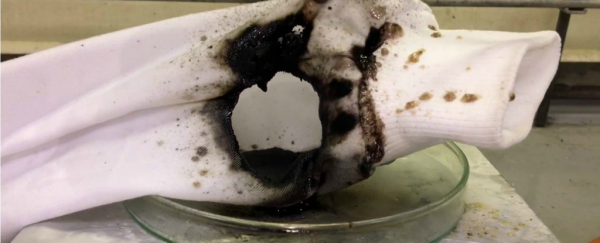When it comes to experiments, we're always telling people to put safety first and wear goggles and a lab coat. And while that white fabric offers pretty great protection against most run-of-the-mill chemicals, have you ever wondered how well it would protect you if things got really hairy in the lab?
This video from Chemistry Flicks shows what happens when 'superacid' chlorosulfonic acid gets spilled - and, in case you hadn't noticed, things don't go so well for the lab coat.
To be clear, you'd still pull up a whole lot better during a chlorosulfonic acid spill if you were wearing a lab coat than if you weren't - just imagine that liquid coming in contact with your bare skin - so we're in no way condoning going lab-coat-free here.
But it's interesting - and a little scary - to see that there are chemicals out there that can burn through our protective gear in a matter of seconds.
Chlorosulfonic acid is produced when hydrogen chloride reacts with a solution of sulphur trioxide in sulphuric acid, and it's mostly used in industrial processes (for example, synthesising detergents) so it's not something you're likely to come in contact with in your school lab.
But if you do, try your best to avoid it, because the chemical gets its 'superacid' nickname from the fact it has an acidity greater than 100 percent pure sulphuric acid. Which, as you can imagine, makes it pretty corrosive.
So why do we wear lab coats if they dissolve in the presence of certain chemicals? As we mentioned earlier, if something's going to spill on you, it's far preferable for it to spend 10 to 20 seconds chewing through thick, white fabric - giving you the chance to rip the lab coat off - rather than landing directly on your skin.
There are also different types of lab coats - scientists have now developed flame-resistant materials and fabric infused with Kevlar to make them even stronger.
Of course, there's nothing out there that's going to protect you from every possible accident - we'd like to see how a lab coat holds up against this hydraulic press, for example - but the point of safety gear is that it keeps you as safe as possible while being fairly unobstructive.
So go and button up that lab coat and feel safe knowing that it can't protect against everything, but it's going to be a lot better than your skin when it comes to handling acid.
And to make you feel a little bit better about the resilience of your favourite lab garment, here's what chlorosulfonic acid does to a daffodil.
And, uh, it probably goes without saying, but don't try this at home. Stay safe out there, science lovers.
